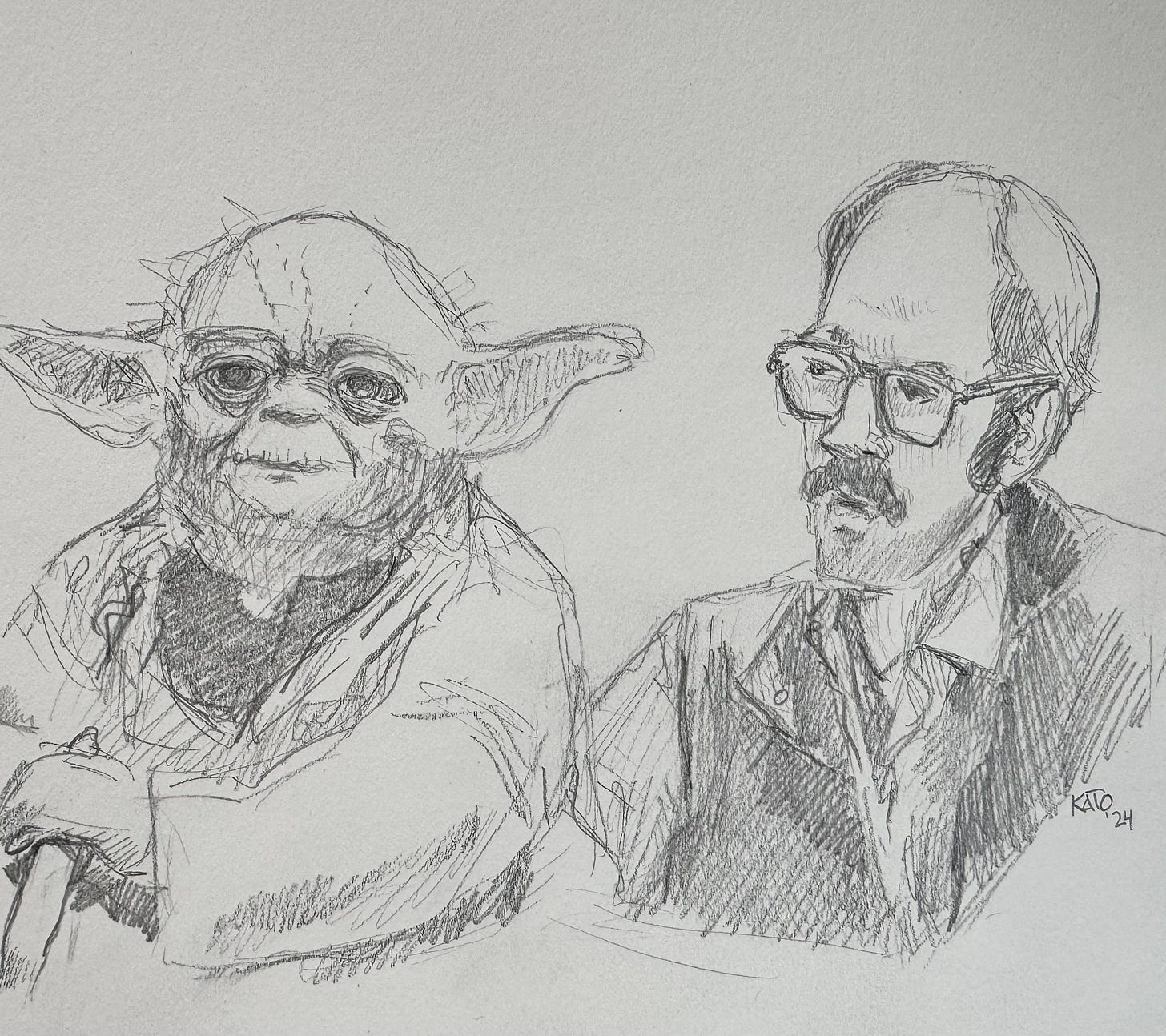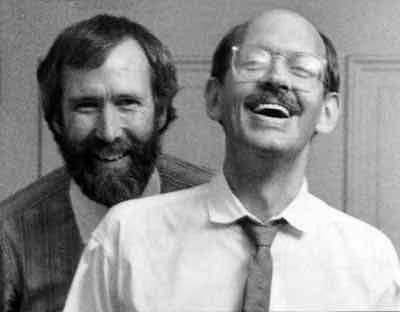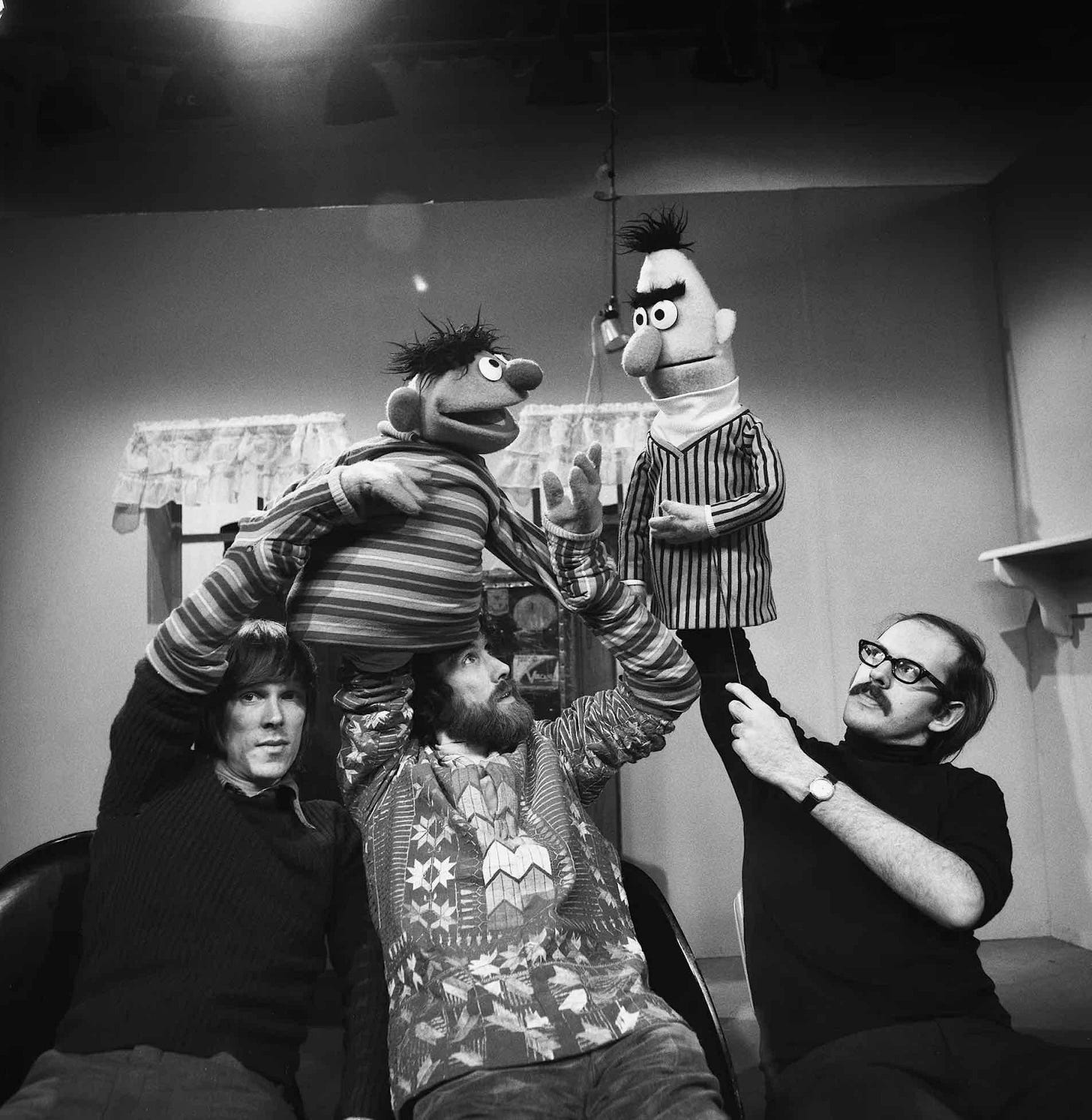Wolf Criers Club
Vol 23
This week Wolf Criers Kato McNickle and Kevin Wilkins reflect on the work of puppeteer and filmmaker Frank Oz.
Yoda Man
by Kato McNickle
Puppets have fascinated me my entire life. I’m sure it began with Rankin and Bass and their Rudolph the Red-Nosed Reindeer TV special that aired every year at holiday time. And who doesn’t delight seeing The Lonely Goatherd number in the film The Sound of Music? And of course, learning to count and read and say “Cooooooookie” with all the O’s made learning fun on Sesame Street.
But the thing that sparked my exploration of making and working with puppets came from a behind-the-scenes segment I saw with Jim Henson and Frank Oz in my early teens. They explained the construction of the muppets and then they showed how they make them seem to speak and breathe.
To make a muppet speak, you have to open your hand on the syllables. Many people naturally close their fingers when making a sock-puppet speak. The illusion comes from opening the hand and rolling the fingers to make a vowel sound. They demonstrated how they make a muppet seem to walk or sleep or eat through the puppeteer’s posture and coordinated movements.
I started practicing with my hands in my mittens and then began making puppets from old pieces of cloth and fur. These skills have benefitted me throughout my career in theater. And now that I’m making picture books, the same skills that make puppet stages seem alive help to make picture book scenes pop.
Many of the crossover adaptations of picture books to stage productions include puppetry in their design. Puppets can be very large or tiny. They can appear to grow or fly or pounce. Anyone who has seen the stage adaptation of Warhorse can attest to the emotional impact of puppets on stage.
Of course, as a Star Wars fan, I cannot think of Frank Oz and not have Yoda at top of mind. I recently watched the documentary Empire of Dreams about the making of the original three Star Wars films. One of the things discussed is the chance the production team was taking staking the film on a main character represented by a puppet. If the puppet couldn’t seem genuine then the entire film would fail.
Talk about pressure.
After watching the documentary, I could not wait to revisit Empire Strikes Back. Even with the behind-the-scenes technical aspects fresh in my brain, I still forgot that Yoda was a puppet with an operator team under the stage.
How different would our pop-cultural landscape be if Frank Oz and Jim Henson had not been collaborators and artistic partners?
Do you have a favorite muppet, puppet, or animated character? Tell us about it in the comments.
The right hand of Genius
Inspiration from Frank Richard “OZ” Oznowicz
by Kevin Wilkins
It is always good to hear what people say about themselves and the things that matter to them in their own words. Here are some of the thoughts that Frank Oz, the man, the myth, the muppet, has said in his own words.
In a 2021 interview with Rolling Stone Magazine Oz said:
I began as a puppeteer when I was about 12 years old. And when I was about 18, I said, No more of this. I stopped it because I wanted to be a journalist. Then, about halfway into studying that in junior college in Oakland, Jim Henson asked me to join him as a puppeteer. So here’s the very thing I quit. Now I’m being asked to do it again. And then I somehow got to be better at it, after years and years of working with Jim and Jane Henson. So I kept on doing it and doing it.
On the one hand, there was this joy of working with these people I love and the [Muppet] characters. It was such an incredible, golden time. And on the other hand, there’s an underlying dissatisfaction that that’s all I was doing. Then I started with Jim as co-director of The Dark Crystal, and I was happy I was doing something else. Although I was just learning. And after Dark Crystal, I directed Muppets take Manhattan, and that was successful. So then David Geffen asked me to do Little Shop of Horrors. And that was successful. Then Dirty Rotten Scoundrels. And I just kept on doing these large, popular comedies. Then I finally stopped and said, I want to do a heist movie. And we did that, The Score.
But all that time, I never tried to be a popular film director. I just happened to be successful. And every time I didn’t screw up, they asked me again. I love directing, so it was great. However, there was that part of me that was a bit more rebellious, that was drawn to controlled anarchy — which actually was the Muppets in the very beginning, when it was about four of us in two rooms. It was more experimental. That was great. But then, again, we got successful. So I’m really coming back to that kind of experimental feeling that we had in the first year or two in the Muppets. That’s where my heart always has been, in that kind of that art. I don’t know if you call it rebellious, I don’t know if you call anarchic, but certainly not status quo.
More Frank Oz thoughts:
If you look at a lot of the pieces on the Muppet Show (1976) that came from Jim, there was a tremendous sweetness about them, and that's unique to Jim. Jim was never wimpy. He had a strength to his sweetness... that was great.
I look back on my work and I think, 'Oh, why didn't I do that differently?’
What we need the magic for — or whatever you call it, illusion, magic, whatever — is each of those moments are sparks to continue the story. And underneath is the real story, the real struggle. And [the audience doesn’t] know it, but they feel it. And that’s why they’re connected to it.
Every character I bring to life has a little bit of my own personality in it.
We’re all struggling. That’s the very core of our being. And if there’s no struggle, I don’t think it’s worth it. Because those struggles that you have inside yourself are the only things that connect with people.”
I've learned that true success comes when you create something that makes people feel something.
Frankness is essential in storytelling. It allows the audience to connect with the characters on a deeper level.
I want to get into the theater. I really wanted to be a theater director, but I turned out to be a movie director.
[on Little Shop of Horrors (1986)] Howard Ashman gave me the best advice of anybody ever, regarding directing this kind of a movie. He said, "Frank, this is supposed to be stupid." And it was the best advice. He said, "My tongue was firmly in my cheek when I wrote this.”
Authenticity is the key to connecting with an audience. People can tell when you're not being true to yourself.
I'm not making art, I think that's too highfalutin'. I'm just doing my best. Someone else can tell me whether it's art or not. In the meantime, I just want everyone else to enjoy it.
I don’t like labels, because labels lead to stereotypes. And stereotypes lead to limitations of human beings.
Humor has always been a big part of my life. It's how I cope and how I connect with others.
I've learned that you have to trust the process and let go of control in order for something magical to happen.
Passion drives me to create art that transcends boundaries and speaks to people on a deeper level.
Life is too short to take everything so seriously. Sometimes, we just need to laugh at ourselves.
Every puppet I create is like a piece of me that gets to live and breathe on its own.
Laughter is the ultimate form of rebellion—it's a way to challenge the status quo and bring about change through joy.
Sure there's a difference with puppet-craft - who cares? I don't care about the puppet-craft, I care about what works. Who cares about the puppet and craft? It's not about that. It's about compelling an audience, and touching an audience in some way.
I just want to do good work. That's all I want to do. I don't have big aspirations like being the President of the United States, I just want to do good work. That's all.
I don't look back, I just go forward. I'm just proud of the fact that my parents were immigrants and we had nearly nothing, and all of the sudden, with the help of a lot of people and my parents as a model, I amounted to something.
If you would like more in Frank Oz’s own words a recently released Muppet Guys Talking, a documentary available exclusively on muppetguystalking.com site. It captures a conversation he had with fellow Muppet performers Dave Goelz, Fran Brill, Bill Barretta, and the late Jerry Nelson. Their memories, blended with archival behind-the-scenes footage, reveal the spirit of creativity nurtured by Jim Henson.
Kato McNickle and Kevin Wilkins composed this week’s newsletter.
Wolf Criers Club is a collective of illustrators, writers, innovators, and wolves. We explore aspects of dynamic storytelling each week through pictures and words, how to improve, and where to take it next. Why not run with us?
If you enjoy this post, please share it with arts-minded friends and subscribe or follow Wolf Criers Club on Substack for weekly updates.
The wolf-wearing-glasses logo is by Wolf Crier Michael Luk.







I really loved the reflections in this week's newsletter as well. I love Frank Oz’s work. Fozzie Bear and Cookie Monster. I think Yoda will be the most remembered character.
My favorite Sesame Street characters are Cookie Monster and Kermit. You gotta love Kermit singing "The Rainbow Connection" song. Jim Henson sang the song, and the music and lyrics were written by Paul Williams and Kenny Ascher. Speaking of Paul Williams, did anyone ever see the movie “Bugsy Malone?”
I just randomly listened to his conversation on the Mike Birbiglia podcast yesterday 🤯
https://podcasts.apple.com/us/podcast/mike-birbiglias-working-it-out/id1515419751?i=1000506448024